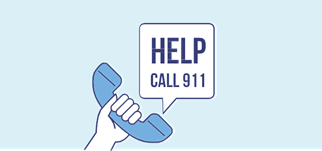 Call:
Call:
Shout and gently tap the child’s foot. If you do not see a response, position the infant on his or her back. If you are alone with the child, give two minutes of CPR before calling 911. The emergency dispatcher will assist you with CPR instructions.
 Blow:
Blow:
Keep the head in a neutral position and listen for breathing. Look to see if the chest rises. Feel for the flow of air against your cheek. If the infant is not breathing, cover the baby’s mouth and nose with your mouth, and give two gentle breaths. Each breath should be about one second long. You should see the infant’s chest rise with each breath.
- Pump:
Give 30 gentle chest compressions. Position two or three fingers in the center of the infant’s chest just below the nipples. Press down about one-third the depth of the chest, about 1 1/2 inches. Pump at a rate of at least 100 compressions per minute. Allow the chest to return to its normal position between pushes. - Repeat:
Continue with the pattern of two breaths and 30 compressions until help arrives. After five cycles or about two minutes, call 911, and continue giving breaths and compressions as needed. Do not interrupt chest pushing for more than 10 seconds.
Sudden Infant Death Syndrome
(SIDS) SIDS is the sudden death of an infant under one year of age that remains unexplained after a thorough investigation.
How to reduce your baby’s risk of SIDS
- Put the baby on his or her back to sleep.
- Use a firm, tight fitting mattress in a crib that meets current safety standards.
- Remove pillows, quilts, comforters, sheepskins, stuffed toys, and other soft products from the crib.
- Dress your baby in sleep clothing so that you will not have to use blankets or any other covering.
- Keep your baby warm but not too warm.
- Make sure the baby’s head remains uncovered.
- Understand the dangers of soft bedding.
- Avoid adult beds, waterbeds, sofas or other soft surfaces for sleep.
Source: National SIDS/Infant Death Resource Center (NSIDRC). For more information, visit https://sidscenter.org or call (866) 866-7437.
